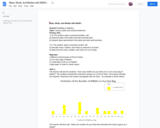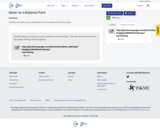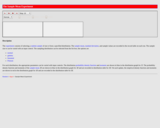
Describing and determining mean, median, mode, and range of a set of data - Mathematics Instructional Plan
- Subject:
- Mathematics
- Material Type:
- Lesson Plan
- Provider:
- VDOE
- Author:
- VDOE
- Date Added:
- 10/07/2024

Describing and determining mean, median, mode, and range of a set of data - Mathematics Instructional Plan

Screen Time Task Template, Student Version of Task, Anchor Pages and Scoring Rationale

Balancing Act Mathematics Instructional Plan

Formative Assessment - Identify and describe properties of a normal distribution - Just in Time Quick Check, Teacher Notes, and Supporting Resources

Formative Assessment - Interpret and compare z-scores for normally distributed data - Just in Time Quick Check, Teacher Notes, and Supporting Resources

Student will:analyze a map of the Chesapeake Baycalculate the mean, median, mode, range, and numbercreate an appropriate graphinvestigate data provided by the James River and apply learning

This is a google slides mini lesson on finding the mean of a set of data. The first slide consists of the definition of mean. Students will solve what a mean is and will make a text box and type the answer in it, then complete the slides.

Just in Time Quick Check Measures of Center

Just in Time Quick Check Mean as Fair Share

Just in Time Quick Check Determine Mean, Median, Mode, and Range

Just in Time Quick Check Mean as a Balance Point

Mic Drop Maths is a mathematics podcast for 5th graders based on the VA Standards of Learning. Each episode addresses one standard and is broken into segments including concept, real-world application, math history, literature connections, misconceptions, and more! There is music, sound effects, jokes, and student voice in each engaging and entertaining episode.

This resource involves students completing a series of four graphs representing how many M&M's they predict are in fun size and small bags of M&M's, and the actual number that are present. After collecting data and graphing the results, students will place the data on stem and leaf plots. Next, students will determine the mean, mode, and median for each set of data, and decide which measure of center is most accurate for describing the number of M&M's in the bag. Lastly, students will compare the amount of M&Ms in the fun size bag to those in the small bag.

Students will work on the Jamboard to move counters to find the mean.

The resource consists of a Java applet and expository text. The applet illustrates the distribution of the sample mean of a random sample from a given distribution. The sample size and the sampling distribution can be specified. The applet illustrates the central limit theorem.